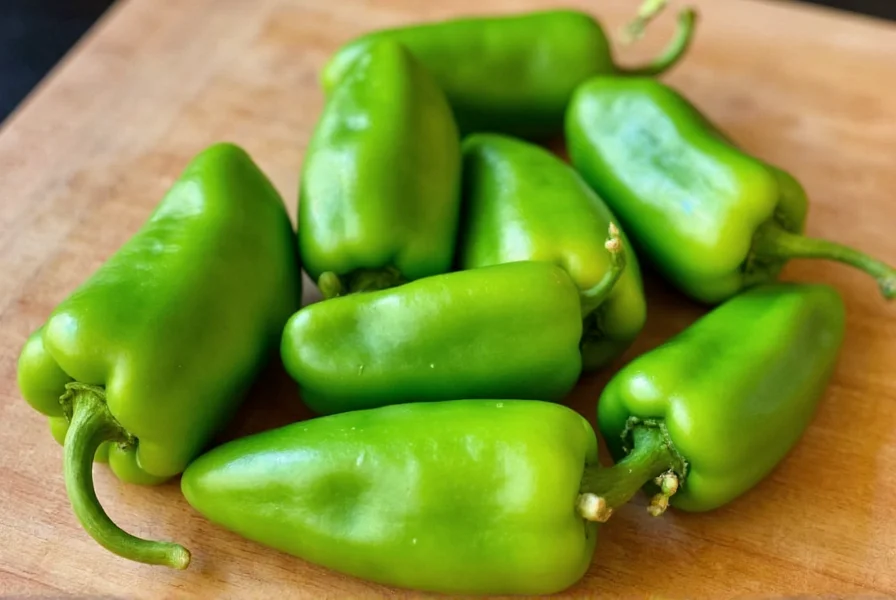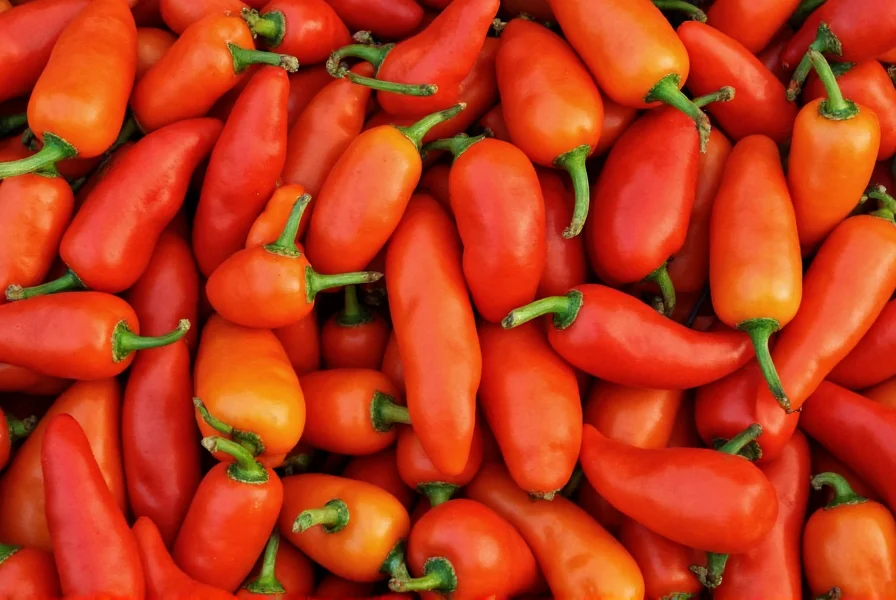Anaheim peppers, scientifically classified as Capsicum annuum, represent one of America's most versatile and widely used chili peppers. Originally developed by Spanish missionaries in New Mexico during the 1500s, these peppers gained their name from the California city where they became commercially popular in the early 20th century. Understanding their unique characteristics helps home cooks and culinary professionals make the most of this kitchen staple.
Physical Characteristics and Identification
Anaheim peppers typically measure 6-10 inches in length with a slender, slightly curved shape. When immature, they display a vibrant green color that transitions through yellow and orange to a deep red as they fully ripen. The walls are relatively thin compared to bell peppers but thicker than jalapeños, making them ideal for roasting and stuffing. Their tapered shape with a distinctive curve near the stem helps differentiate them from similar varieties like the poblano.
| Pepper Characteristic | Anaheim Pepper | Comparison to Jalapeño |
|---|---|---|
| Heat Level (Scoville) | 500-2,500 units | 2-13x milder (2,500-8,000) |
| Typical Length | 6-10 inches | 2-3x longer |
| Wall Thickness | Moderate | Thinner walls |
| Flavor Profile | Grassy, slightly sweet | More vegetal, sharper |
Heat Level and Flavor Profile
Understanding anaheim pepper heat level is crucial for recipe planning. These peppers register between 500-2,500 Scoville Heat Units, placing them firmly in the mild to medium category. For context, they're significantly milder than jalapeños (which range from 2,500-8,000 SHU) but offer more heat than bell peppers (0 SHU). The heat can vary considerably based on growing conditions, with peppers from hotter, drier climates typically developing more capsaicin.
The flavor profile features a distinctive grassy, slightly sweet taste with earthy undertones. When roasted, Anaheim peppers develop a complex smoky-sweet flavor that makes them ideal for roasting anaheim peppers techniques used in Southwestern cuisine. Their moderate heat allows the pepper's natural flavor to shine through without overwhelming other ingredients.
Culinary Applications and Recipe Ideas
Chefs value Anaheim peppers for their versatility across cooking methods. They excel in:
- Stuffed pepper dishes - Their size and shape make them perfect vessels for rice, cheese, and meat fillings
- Salsas and sauces - Providing mild heat without dominating other flavors
- Chile rellenos - The traditional Mexican dish featuring roasted, stuffed peppers
- Strips in fajitas - Offering milder alternative to bell peppers
- Pickled preparations - Their firm texture holds up well to vinegar-based brines
For home cooks wondering how to use anaheim peppers in cooking, try roasting them over an open flame until blistered, then steaming in a covered bowl to loosen the skin. This technique enhances their natural sweetness while reducing raw vegetal notes. The roasted peppers freeze exceptionally well for year-round use.

Substitution Guide
When you can't find Anaheim peppers, understanding appropriate anaheim pepper substitute options becomes essential. The best alternatives depend on whether you prioritize heat level, flavor, or physical characteristics:
- For mild heat and similar flavor: Poblano peppers (slightly hotter but similar earthy flavor)
- For identical heat level: Cubanelle peppers (milder, thinner-walled alternative)
- For recipe structure (stuffing): Large bell peppers (no heat but similar size/shape)
- For roasted applications: Mix equal parts bell pepper and jalapeño (adjusting for desired heat)
When substituting, remember that anaheim pepper vs jalapeno comparisons show significant differences in both heat and texture. Jalapeños deliver concentrated heat with thicker walls, while Anaheims provide more volume with milder, distributed heat.
Growing and Selection Tips
Gardeners interested in growing anaheim peppers should note they require 70-80 days to maturity and thrive in warm climates with full sun exposure. The plants typically reach 24-30 inches in height and produce abundant yields when properly watered and fertilized.
When selecting fresh peppers at the market, look for firm specimens with smooth, glossy skin and vibrant color. Avoid those with wrinkles, soft spots, or discoloration. Green Anaheims should feel heavy for their size, indicating proper moisture content. Store them in the refrigerator's crisper drawer for up to two weeks, or freeze roasted peppers for longer storage.

Nutritional Benefits
Anaheim peppers contribute valuable nutrients to your diet. A single medium pepper provides:
- 130% of the daily recommended vitamin C
- 20% of vitamin A requirements
- Good source of vitamin B6 and potassium
- Nearly 2 grams of dietary fiber
- Only 25 calories per pepper
The capsaicin present in are anaheim peppers hot enough to provide metabolic benefits without overwhelming heat. Regular consumption may support cardiovascular health and provide anti-inflammatory effects, though these benefits are more pronounced in hotter pepper varieties.
Common Misconceptions
Several myths surround Anaheim peppers that deserve clarification. Despite frequent confusion, Anaheim peppers are not the same as California peppers (a marketing term that often refers to Anaheims), and they differ significantly from New Mexico chiles despite the shared regional history. The misconception that what does an anaheim pepper look like differs from poblano peppers is also common—while similar, Anaheims are longer and narrower with thinner walls.
Frequently Asked Questions
How hot are Anaheim peppers compared to other common varieties?
Anaheim peppers measure 500-2,500 Scoville Heat Units, making them significantly milder than jalapeños (2,500-8,000 SHU) but hotter than bell peppers (0 SHU). They're about 2-13 times milder than jalapeños depending on the specific peppers compared.
Can I substitute Anaheim peppers in recipes calling for poblanos?
Yes, Anaheim peppers make a good substitute for poblanos in most recipes, though they're slightly milder and have thinner walls. Use a 1:1 substitution ratio, but be aware that Anaheims may cook faster due to their thinner flesh. For stuffed pepper dishes, you might need to adjust cooking times downward.
What's the best way to prepare Anaheim peppers for cooking?
Roasting is the preferred preparation method for Anaheim peppers. Char them over an open flame or under a broiler until blistered, then place in a covered bowl for 10 minutes to steam. This loosens the skin, which can then be easily peeled off. The roasted peppers can be used immediately or frozen for later use.
Do Anaheim peppers change flavor as they ripen from green to red?
Yes, Anaheim peppers develop significantly sweeter, fruitier flavors as they mature from green to red. Green Anaheims have a grassier, more vegetal taste, while red versions offer deeper, sweeter notes with reduced bitterness. Red Anaheims also contain more capsaicin, making them slightly hotter than their green counterparts.
How should I store fresh Anaheim peppers for maximum shelf life?
Store fresh Anaheim peppers in the refrigerator's crisper drawer in a perforated plastic bag for up to two weeks. For longer storage, roast and peel them, then freeze in airtight containers for up to six months. Avoid washing peppers until ready to use, as excess moisture accelerates spoilage.











 浙公网安备
33010002000092号
浙公网安备
33010002000092号 浙B2-20120091-4
浙B2-20120091-4